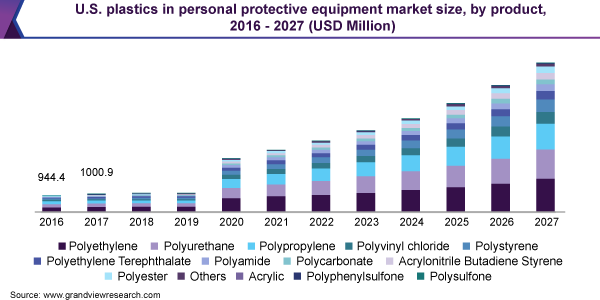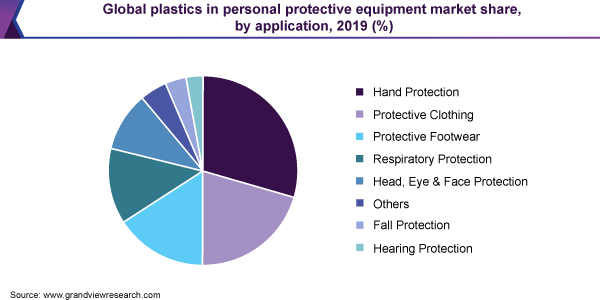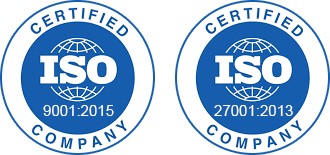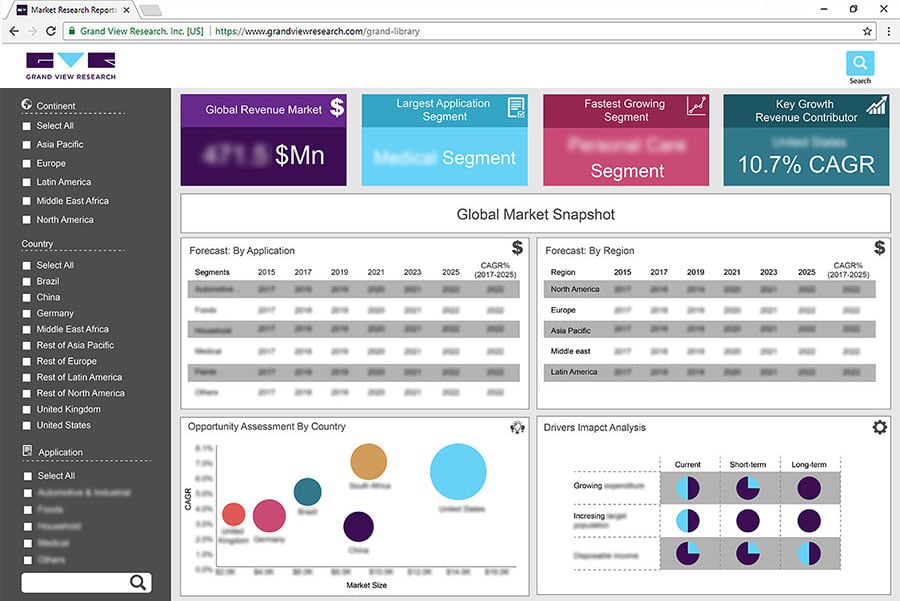- Home
- »
- Plastics, Polymers & Resins
- »
-
Plastics In Personal Protective Equipment Market Report 2027GVR Report cover
![Plastics In Personal Protective Equipment Market Size, Share & Trends Report]()
Plastics In Personal Protective Equipment Market Size, Share & Trends Analysis Report By Product (Polyester, PE), By Application (Hand, Respiratory Protection), By Region, And Segment Forecasts, 2020 - 2027
- Report ID: GVR-4-68038-802-2
- Number of Report Pages: 110
- Format: PDF, Horizon Databook
- Historical Range: 2016 - 2018
- Forecast Period: 2020 - 2027
- Industry: Bulk Chemicals
Report Overview
The global plastics in personal protective equipment market size was valued at USD 3.8 billion in 2019 and is expected to grow at a compound annual growth rate (CAGR) of 17.0% from 2020 to 2027. Increasing demand for plastics in the production of personal protective equipment, which are used in various industries including construction, chemicals, food processing, and others, is projected to support the plastic in PPE market growth over the forecast period. Amid the global COVID-19 pandemic situation, the demand for various PPE products, such as gloves, face masks and shields, head covers, shoe covers, and protective gowns, has increased. This, in turn, is driving the demand for plastics in PPE in head, eye & face protection, protective clothing, and respiratory protection applications.

The respiratory protection segment, in particular, is expected to register the fastest growth rate over the forecast period. The rapid expansion of the construction industry in emerging markets, such as Brazil, China, India, and Mexico, is expected to drive the demand for PPE products, such as safety vests & belts, helmets, and gloves, over the forecast period, thereby supporting market growth.
Moreover, increased foreign investments in the construction sectors of these countries, as a result of flexible FDI norms and the need for redevelopment of public and industrial infrastructure, will drive the market. The growing demand for pharmaceuticals and chemicals to tackle the COVID-19 pandemic situation is also driving the product demand, which will propel the market growth over the forecast period.
Product Insights
Polyethylene (PE) product segment led the market and accounted for more than 25% share of the global revenue in 2019. This significant share is attributed to it’s the properties of PE, such as excellent resistance against chemicals like solvents, alcohols, and dilute acids. Polyethylene is primarily used to manufacture gloves, protective suits, head covers, helmets, face shields, and others. The ability of the material to provide moisture barrier is driving its demand across several applications.
Polypropylene (PP) is widely used in the production of protective suits and shoe covers, which have a high demand due to the COVID-19 pandemic. Increasing corona positive cases and the resultant rise in the number of healthcare facilities across the globe are driving the demand for protective suits for doctors and other healthcare workers. This will drive the segment growth over the forecast period.
Polyester is projected to be the fastest-growing product segment over the forecast period. Rising demand for polyester can be attributed to increasing production of safety vests, gloves, helmets, masks, knee pads, and several other products, which are used in industries, such as construction, oil & gas, and food processing. The rising number of construction & infrastructure development activities is expected to drive the PPE products demand, which will boost the segment growth over the forecast period.
Application Insights
The hand protection application segment led the market and accounted for more than a 29% share of the global revenue in 2019. Amid the global pandemic situation, most of the people have started using surgical gloves to protect themselves from the coronavirus, which is a major factor boosting the segment growth.
Gloves are used in various industries, such as construction, electrical and electronics, and food processing. Depending upon the requirement, such as electrical insulation, chemical resistance, water & moisture barrier, and others, theses hand protection gloves are produced. The demand for these gloves will increase due to the COVID-19 pandemic.

Various automotive companies such as Ford Motor Company, General Motors Company, and Tesla have started producing face masks to cater to the rising demand for PPE, which will contribute to the market growth.
Regional Insights
Asia Pacific dominated the market and accounted for over 47% share of global revenue in 2019. Asia Pacific healthcare industry is expected to grow on account of rising COVID-19 positive cases, which is expected to drive the demand for protective masks, suits, face shields, gloves, and other PPE products. Asia Pacific is also estimated to be the fastest-growing regional market owing to the rising healthcare expenditure in the countries, such as China, India, and Japan.
In addition, the presence of various personal protective equipment manufacturers in the region, such as Mallcom (India) Ltd., SGS SA, and Asma Rubber Products Pvt. Ltd., will propel industry expansion over the forecast period. Moreover, the construction industry is expected to witness considerable growth in the region owing to increasing demand for non-residential construction projects, such as hospitals and colleges, which will drive the demand for PPE products, such as safety vests, helmets, and safety belts.
North America ranks second, in terms of revenue. However, the regional market is expected to witness sluggish growth as the cross-border trade among the economies got affected on account of the COVID-19 pandemic. On the other hand, the growth of the major end-use industries, such as healthcare, construction, and food processing & packaging, will drive the market. Moreover, rising demand for PP and Acrylonitrile Butadiene Styrene (ABS) in the production of masks, gloves, face shields, and various other personal protective equipment products will support market growth.
Key Companies & Market Share Insights
Companies in the market compete on the basis of product quality and technology used in product manufacturing. Major players are mainly focusing on R&D, expansion of their manufacturing facilities, infrastructural development, and are seeking opportunities to vertically integrate across the value chain. These initiatives help them cater to the increasing global demand, ensure competitive effectiveness, enhance their sales & operations planning, and expand their customer base. The global market is found to be significantly fragmented in nature owing to the presence of a large number of manufacturers across the globe. Some of the prominent players in the plastics in personal protective equipment market include:
-
BASF SE
-
SABIC
-
Evonik Industries AG
-
Sumitomo Chemical Co., Ltd.
-
Arkema
-
Celanese Corporation
-
Eastman Chemical Company
-
Chevron Phillips Chemical Company
-
Exxon Mobil Corporation
-
Covestro AG
Plastics In Personal Protective Equipment Market Report Scope
Report Attribute
Details
Market size value in 2020
USD 11.5 billion
Revenue forecast in 2027
USD 34.8 billion
Growth Rate
CAGR of 17.0% from 2020 to 2027
Base year for estimation
2019
Historical data
2016 - 2018
Forecast period
2020 - 2027
Quantitative units
Volume in kilotons, revenue in USD million and CAGR from 2020 to 2027
Report coverage
Volume forecast, revenue forecast, competitive landscape, growth factors and trends
Segments covered
Product, application, region
Regional scope
North America; Europe; Asia Pacific; Central & South America; Middle East & Africa
Country Scope
U.S.; Canada; Mexico; Germany; U.K.; France; Italy; China; India; Japan; Brazil; Saudi Arabia
Key companies profiled
BASF SE; SABIC; Evonik Industries AG; Sumitomo Chemical Co., Ltd.; Arkema; Celanese Corporation; Eastman Chemical Company; Chevron Phillips Chemical Company; Exxon Mobil Corporation; Covestro AG
Customization scope
Free report customization (equivalent up to 8 analysts working days) with purchase. Addition or alteration to country, regional & segment scope.
Pricing and purchase options
Avail customized purchase options to meet your exact research needs. Explore purchase options
Segments Covered in the Report
This report forecasts revenue and volume growth at global, regional, and country levels and provides an analysis of the latest industry trends in each of the sub-segments from 2016 to 2027. Grand View Research has segmented the global plastics in personal protective equipment market report on the basis of product, application, and region:
-
Product Outlook (Volume, Kilotons; Revenue, USD Million, 2016 - 2027)
-
Polyethylene (PE)
-
Polypropylene (PP)
-
Polyurethane (PU)
-
Polyvinyl chloride (PVC)
-
Polyethylene terephthalate (PET)
-
Polystyrene (PS)
-
Acrylonitrile butadiene styrene (ABS)
-
Polycarbonate (PC)
-
Polyamide (PA)
-
Polysulfone (PSU)
-
Polyphenylsulfone (PPSU)
-
Acrylic
-
Polyester
-
Others
-
-
Application Outlook (Volume, Kilotons; Revenue, USD Million, 2016 - 2027)
-
Head, Eye & Face Protection
-
Hearing Protection
-
Protective Clothing
-
Respiratory Protection
-
Protective Footwear
-
Fall Protection
-
Hand Protection
-
Others
-
-
Regional Outlook (Volume, Kilotons; Revenue, USD Million, 2016 - 2027)
-
North America
-
The U.S.
-
Canada
-
Mexico
-
-
Europe
-
Germany
-
The U.K.
-
France
-
Italy
-
-
Asia Pacific
-
China
-
India
-
Japan
-
-
Central & South America
-
Brazil
-
-
Middle East & Africa
-
Saudi Arabia
-
-
Frequently Asked Questions About This Report
b. The global plastics in personal protective equipment market size were estimated at USD 3.8 billion in 2019 and is expected to reach USD 11.5 billion in 2020.
b. The global plastics in personal protective equipment market is expected to grow at a compound annual growth rate of 17.0% from 2020 to 2027 to reach USD 34.8 billion by 2027.
b. Asia Pacific dominated the plastics in personal protective equipment market with a share of 47.6% in 2019. This is attributable to increasing COVID-19 cases which is expected to boost the demand for the mask, face shields, gloves, etc.
b. Some of the key players operating in the plastics in plastics in personal protective equipment market include BASF SE; SABIC; Evonik Industries AG; Sumitomo Chemical Co., Ltd.; Arkema; Celanese Corporation; Eastman Chemical Company; Chevron Phillips Chemical Company; Exxon Mobil Corporation; and Covestro AG.
b. Key factors driving the plastics in plastics in personal protective equipment market growth include rising healthcare awareness among the consumers, rising demand for personal protective equipment from medical frontiers; and favorable government initiatives regarding sustainable products.
Share this report with your colleague or friend.
![gvr icn]()
NEED A CUSTOM REPORT?
We can customize every report - free of charge - including purchasing stand-alone sections or country-level reports, as well as offer affordable discounts for start-ups & universities. Contact us now
![Certified Icon]()
We are GDPR and CCPA compliant! Your transaction & personal information is safe and secure. For more details, please read our privacy policy.
We are committed towards customer satisfaction, and quality service.
"The quality of research they have done for us has been excellent."





